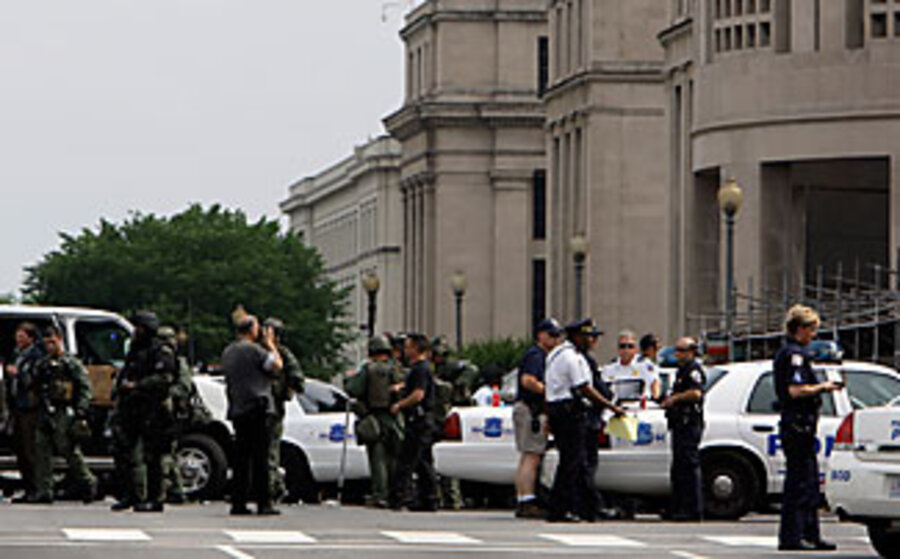Holocaust Museum shooting: A spike in domestic extremism?
Loading...
The shooting at Washington's Holocaust Museum by a notorious white supremacist Wednesday, which left one security guard dead, underscores a growing concern among analysts and government officials about a potential rise in domestic extremism.
Authorities say James Von Brunn entered the museum with a rifle and began shooting, before he himself was shot, leaving the octogenarian in critical condition. Mr. Von Brunn's car, parked near the museum, has also tested positive for explosives, AP reports.
Von Brunn is well known to anti-extremist experts, having written countless invectives against Jews and blacks on the Web. He also was imprisoned in the 1980s for attempting to accost the Federal Reserve board members while waving a pistol – apparently angered by high interest rates and inflation.
Wednesday's attack is the third shooting by an extremist in the past 10 days in the United States. Experts say the shootings suggest that "lone wolf" extremism unaffiliated with any organization could be spreading, fueled both by overseas anti-American fervor as well as by homegrown right-wing groups angered by the state of the economy and the election of the nation's first black president.
Last Sunday, an anti-abortion activist killed a well-known abortion doctor in Kansas, leading to the closing of the clinic. The following day, an American convert to Islam opened fire on two US soldiers taking a break outside a Little Rock, Ark., Army-Navy recruiting office, killing one and injuring the other.
In a controversial document released earlier this year, the Department of Homeland Security warned that "a number of economic and political factors are driving a resurgence in right-wing extremist recruitment and radicalization activity." The report was later retracted because it claimed that disgruntled veterans were possible converts to right-wing extremism – a point that infuriated veterans' groups. But it cited the economic downturn and the election of a black president as factors in a potential spike in extremist activity.
The "Obama effect ... [has] generated a backlash of white supremacy," Northeastern criminologist Jack Levin told CNN Wednesday. "Jews and blacks in the White House – that's threatening to someone who believes that blacks are subhuman and Jews are the children of the devil."
But Wednesday's shooting also highlights the difficulties of countering the "lone wolf."
The idea of encouraging violent action without actually giving overt directions was pioneered in America by the Ku Klux Klan. Recent adoptees include Oklahoma City bomber Timothy McVeigh, the Unabomber (Theodore Kaczynski), and anti-abortion extremist Eric Rudolph. More recently, Islamic jihadists and groups like the Earth Liberation Front and Animal Liberation Front have also embraced the tactic.
"If you go back to the original leaderless-resistance ideology ... the idea is you have two separate worlds, where above ground you have the organs of information that provide motivation and radicalization, but it has no direct contact at all with the guys doing illegal activity," says Scott Stewart, an analyst with STRATFOR, a global intelligence company in Austin, Texas.
"The idea is to operate within the confines of the First Amendment and use those freedoms to radicalize and point the illegal actors in the second camp," he adds.
Von Brunn, a World War II PT-boat captain, appears to be a textbook example.
The problem is understanding the radicalization process and at what point ideology clicks to spawn an actual operation, counterterrorism experts say. Isolating the "organs of information" that spark violent behavior is a complex task that is extremely difficult in a society governed by the First Amendment and civil liberty protections.
"Somebody yells, 'Kill the umpire!' in the first inning, and then somebody else kills the umpire in the ninth inning. You indict the guy in the ninth inning, but what about the guy who yelled in the first place?" asks Steven Emerson, the author of "Jihad, Inc."
In the cases of Von Brunn and Scott Roeder, who is charged with the murder of abortion doctor George Tiller, the suspects were known to law enforcement and anti-extremism groups. That highlights another reason for the effectiveness of the "lone wolf": It's difficult for law enforcement to interdict potential actors if they haven't openly broken laws or conspired with other people to commit violence.
Von Brunn, for one, had a long-standing association with white supremacists, according to the Anti-Defamation League. He had even penned a book hailing Adolf Hitler. He runs a website called Holy Western Empire, where he quotes Cicero: "A nation can survive its fools and even the ambitions. But it cannot survive treason from within."
"He's a well-known right wing extremist," says Frank Cilluffo, director of the Homeland Security Policy Institute at George Washington University. "It's tragic. The fact that you had someone in their '80s doesn't fit the demographic most people would think you'd have to worry about as far as terrorism is concerned."





